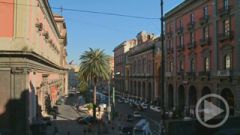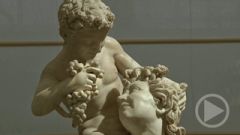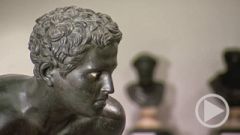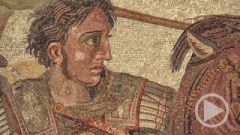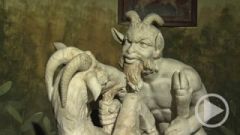The Frescoes
The Frescoes
The excavations begun around the base of Mt. Vesuvius in the 18th century, brought another huge surprise to light. The layers of ash had managed to preserve frescoes that elsewhere had been destroyed by the passage of time.

Such a breathtaking treasure trove of pictures had never been seen before. The houses were steeped in color, the walls were painted from floor to ceiling! Even now, many people do not realize that the ancient world was not pure and white, but highly colorful.
To this day no other site has yielded a comparable hoard of paintings in such an excellent state of preservation. Soon after the discovery, the excavators began removing the frescoes from the walls. The technique they used hardly changed over the following decades: First they chiseled a deep groove around the selected part of the picture and inserted a wooden frame in it. Then they covered the surface of the fresco with a protective piece of canvas and layered plaster over it. That was to keep the painted plaster surface from breaking as blades prized it from the wall. Finally, the detached picture was laid on a slate tablet.

Brought to a museum, and under optimal conditions, the fresco segments could be conserved. After some trials a method was established, involving a protective varnish of wax that was purified and dissolved in turpentine.
But much less care was taken back at the site – and ironically that was precisely because of the enormous respect people had for the finds.
Valeria Sampaolo, Director of the museum:
“At the end of the 18th century and throughout the entire 19th century they had an almost reverential respect for the houses of antiquity. So they did not cover them up, they didn’t build the roofs that would have protected them – just little canopies on the walls. So the sun, the rain and the wind practically ruined 75 percent of the frescoes that have been found up to now.“
This unique model of the excavations is the sole testimony to the original appearance of many of the frescoes. Commissioned by museum curator Giuseppe Fiorelli, who headed the excavations, the model builder Felice Padiglione spent 18 years creating a tiny replica of each house out of cork and paper, and meticulously reconstructing all the pictures and mosaics just as they were in 1879. It is a work of huge historical value – and a work of art in its own right.

In 1882 the German archaeologist August Mau published a book in which he divided the vast assortment of wall paintings in Pompeii into four different styles. Despite some criticism, his classification system is still accepted today.
The oldest, or First Style is also called the Incrustation Style. It first arose in the late fifth century BC in Greece. That was a time when the Greeks had begun to imitate the splendor of large public buildings in their own homes. They painted plaster squares to resemble colored marble blocks. In the early second century BC this trend spread to Italy. A hundred years later, by the first century BC the style underwent a change. In the Second, or Architectural Style, entire buildings were painted in illusionary manner, in great architectural detail. Initially, the paintings showed arrays of columns in front of closed walls of blocks. Later the walls were opened to show halls of columns, temples and entire cityscapes. In the late phase of the Second Style, mythological pictures replaced the outside views.

In the third style of Mau‘s classification, known as the Ornate Style, the picture had become the centerpiece on the wall. The wall was divided into a base, a central panel and an upper zone. Flat, monochrome surfaces dominated. Architectural details were reduced to ornamentation. In the central zone delicate columns or stylized candelabra created a frame for mythological scenes.
Around 40 AD the fashion shifted again. In Pompeii’s last decades the decorations became more individual. Mau’s Fourth, or Intricate Style had numerous different wall types – from solid monochrome backgrounds to staggered arrays of columns and windows. The architectural details were less central – and the shapes became increasingly fanciful. In the final century before Pompeii’s downfall, Greco-Roman myths were popular themes in wall pictures. Many of the frescoes tell the ancient stories of gods and heroes. One of the most popular was the tale of Perseus and Andromeda.

The demi-god Perseus, clad only in winged sandals, has rescued the beautiful Andromeda, who was chained to a cliff to be sacrificed to a monster. Perseus has killed the beast. On Andromeda’s wrist we still see the fetters that Perseus has loosened. Now he helps her to climb down from the rock. Her garment is in disarray, but its richness indicates that the helpless beauty is in fact a king’s daughter. Perseus is actually just stopping by after his greatest act of heroism - ridding the world of the terrible Medusa. He is still holding her severed head in his hand.
These versions of stories that were passed down for centuries in tales and poems are cultural icons. They were at least vaguely familiar to all Romans – rather like Shakespeare’s dramas or Bible stories are today. Episodes from the Trojan War are recurring themes – according to legend, the Romans were descendents of the Trojans.
However, the best-loved pictorial themes were devoted to the beautiful goddess of love, Aphrodite, or the demi-gods Narcissus and Hercules – as well as the god of wine Dionysus and his bride Ariadne. The love affairs of the gods and heroes were extremely popular – they were the great melodramas of the ancient world.
But the walls are not only dominated by great mythological scenes. This decoration has two round ornaments – one showing a young man and the other – as a pendant – a young woman. Her delicate grace has made her portrait famous. Holding a book made of waxed tablets and a stylus, she gazes pensively at the viewer. Perhaps she is thinking philosophical thoughts – or is she composing a poem?
The picture has come to be known as the Sappho Fresco, named after the greatest female poet of antiquity. But it probably does not show any particular person, but rather an idealized beauty. The reference to writing suggests she is educated. Her jewelry shows that she is wealthy, especially the filigree golden hairnet that was fashionable during the reign of Emperor Nero. Pictures of this type known as „puella docta“, or the “learnèd girl” were intended to display the genteel cultivation of a wealthy family.

The woman in THIS picture is gazing at us in the same pose. Again she is the one holding the pen. In the Roman world, writing was a typically female pursuit. She too is wearing a costly red tunic, expensive jewelry and an elaborate, stylish hairdo. The picture hung in the house of the baker Terentius Neo, close to the Forum. It was placed so that everyone passing through the atrium would see that the owner had done so well for himself that he could afford an expensive painter.
However, the portrait gives the impression that the painter may have enjoyed exposing the couple’s unease. He gave Terentius Neo the typical features of the Samnites, a tribe that had migrated to Pompeii from the mountains. Much as the husband and wife are trying to look like cultivated intellectuals, Terentius Neo was no aristocrat, but a nouveau riche baker.


